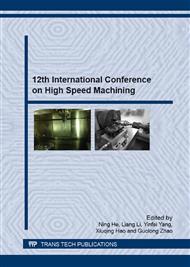p.56
p.64
p.71
p.77
p.88
p.94
p.99
p.106
p.112
Experimental Study on Cutting Force and Cutting Power in High Feed Milling of Ti5Al5Mo5VCrFe
Abstract:
In order to improve the rough machining efficiency of titanium alloy, experiments were carried out to investigate the influence of feed per tooth on cutting force and cutting power with index-able coated carbide inserts. The curves of cutting parameters, including cutting force and cutting power, were obtained by single factor test. The results showed that, as the feed per tooth increases, the cutting force increases, especially in the direction of cutting width. All forces almost changed linearly with the changing of feed, and the cutting force of feed direction was the smallest force among the three directions of cutting force. The analytical model of tangential cutting force in the x-y plane was established. By calculating average chip thickness and relationships between tangential cutting force and measurements of cutting force to predict the cutting power, the calculation results were accurate which compared with the actual output power of the machine tool.
Info:
Periodical:
Pages:
88-93
Citation:
Online since:
January 2016
Keywords:
Price:
Сopyright:
© 2016 Trans Tech Publications Ltd. All Rights Reserved
Share:
Citation:


